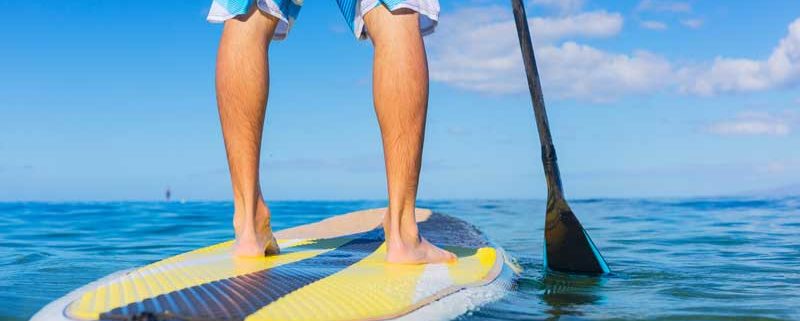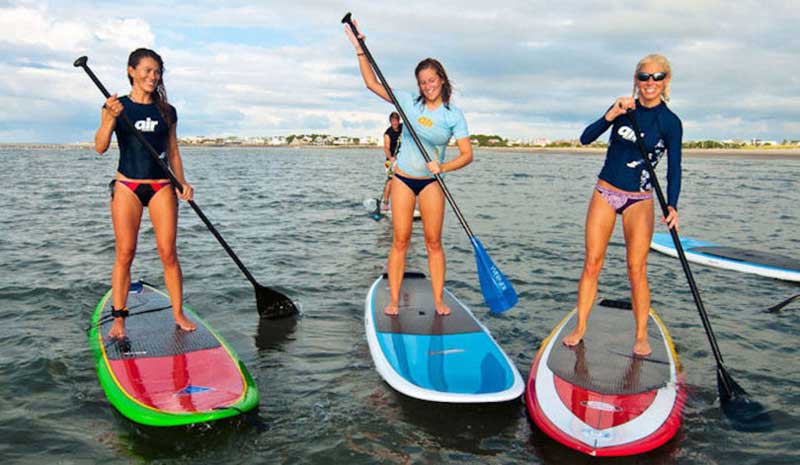A Beginners Guide for Improving Your SUP Paddle Technique
Your experience paddle boarding is only going to be as good as your SUP paddle technique. If you’re having a hard time paddling while on your SUP, you’ll want to check out this article because we’ll give you a few tips and pointers on how to improve your SUP paddle technique!
Stand up paddleboarding is one of the fastest growing outdoor recreation activities. Why?
Because it’s a full body workout that also reduces stress. Oh, and it’s super fun, too. Sign us up.
Newbies and seasoned SUP-pers alike can use a brush up on SUP paddle technique. Keep reading to learn everything you need to know about how to get the most out of your time on the water.
Get the Right Size Paddle
First things first: you have to gear up right if you want to get anywhere on your paddleboard.
Your paddle length is crucial for a successful SUP session. You should choose your paddle length according to your height– your torso height, that is.
Here’s how to measure your torso. Sit up very straight in a chair, and have someone else measure the length between the chair and your nose. That’s your torso length.
Once you’ve got that number in inches, here’s how you use it to determine the right paddle length for you:
- A 22″ torso needs a 180cm long paddle.
- For every 2 extra inches of torso length, add 10-15 cm of paddle length.
- Example: if your torso is 26″ long, your paddle should be about 200-210cm long.
After you determine your paddle length, make sure to account for the width of your board, too. SUP boards vary in size. Wider boards need longer paddles to be sure you’re paddling with the most power.
Stay Loose, but Straight
The two most important things for maximizing strength: your posture and paddle grip.
When it comes to your grip, make sure you’re not holding the paddle too tight. This will force you to work your arms harder than necessary. It’ll also impede your ability to reach the paddle out as far as needed.
A good rule of thumb is to make an O shape with your hands so the paddle can slide with ease in and out of the water. Think of your grip like the rung that a canoe paddle goes through. It’s tight enough to hold the paddle in place without being restrictive.
When it comes to your posture, it’s essential that you keep your back as straight as possible to avoid injury. Your back shouldn’t be doing the bending here, your hips and legs should. Keep your knees bent so your legs are springy, and able to rotate your body as needed.
How to Paddle Board the Right Way
Proper paddling technique is the key to a good workout. Make sure you follow these steps to get the stroke right every time.
Reach Far
As you’re reaching the paddle out at the beginning of the stroke, make sure to reach as far as possible. The farther you reach, the more momentum you’ll create for yourself in the stroke.
If your board is rather wide, this is where a longer paddle will come in handy. It can be tough to reach far enough if your board is taking up prime real estate in the water beside you.
Catch Clean
As your paddle meets the water, make sure to dig deep. Immerse the entire paddle into the water. This’ll allow you to gain the most traction possible during the backstroke.
You’re losing momentum with every inch of the paddle that’s not submerged. It’ll make you have to work harder and make you move slower.
Stay Strong
The backstroke itself is where you’ll need to use your power. Engage your core so the bulk of that strength comes from your legs and lower back, rather than your arms. Your arms should only guide the paddle where it needs to go.
Make sure to keep your back straight as you rotate from side to side. Try to rotate from your hips only, and plant your feet on the board to help work your core.
Prepare for Another
Your release should take place at your feet, and not further back. If you’re releasing much further back, you’re not reaching far enough at the beginning.
Paddle Boarding Basics Tutorial
As you pull your paddle out of the water, keep it as close to the surface as possible. This’ll prepare you for your next stroke. It also won’t add extra stress to your arms to lift the paddle higher than it needs to be.
One great way to learn from the best is to watch professional paddlers on TV. Check out your local cable listings or DStv guide for SUP event screenings and make sure your DStv installation is active and working.
Common Mistakes
That’s the ideal way to pull off one SUP stroke. Here are some of the most common, rookie mistakes that you should try to avoid.
First, using your arms instead of your core to power your strokes. This’ll cause burnout super fast, and won’t give you the full body workout you could be getting. Try to use your arms only to guide the paddle where it needs to be.
The second mistake is keeping your arms too close together. This makes for sloppy paddle technique since you’re sacrificing control over the paddle. Spread your arms out if your paddle feels too wobbly.
The third mistake is looking down at your board or the water instead of out ahead of you. You’re stable, we promise. Keep your eyes on your destination, and the board will follow.
The fourth mistake is not reaching far enough at the beginning of your stroke. This won’t allow you to maximize the force of the stroke, making for a powerful pull forward. Reach, reach, reach!
The last most common mistake is not submerging your paddle deep enough during your catch. Again, this is a missed opportunity for more power in your stroke. Make sure to cover the entire paddle head with water.
Master Your SUP Paddle Technique
Now that you’ve learned how to talk the talk, it’s time to walk the walk and get on your new paddleboard! If you’re a beginner, don’t feel intimidated. If you’re an expert, you can apply these tips to your existing SUP practice.
If you’re in Utah, there are plenty of gorgeous places for you to practice the art of SUP paddle technique.
Do you have questions about SUP paddling, SUP paddling technique, or SUP boards? Get in touch— we love to talk shop!





Leave a Reply
Want to join the discussion?Feel free to contribute!